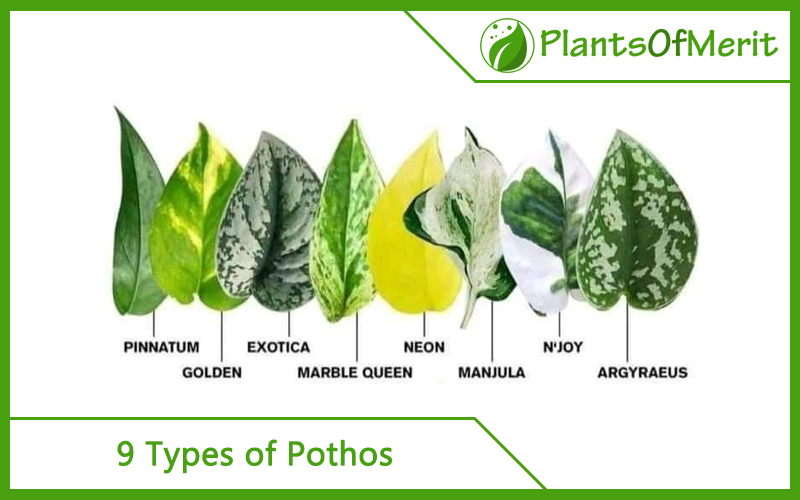When you think about indoor plants, Pothos is generally the first pick. Not only are they easy to grow and care for, but they are extremely versatile as well. You get to choose from a variety of options, all in varying colors, textures, and appearances.
They are very hardy, which means that you can grow them in any area comfortably without any hassle. However, since they are low-light houseplants, you need to keep them indoors in a brightly lit space.
With the right proportion of potting soil and optimal care, you too can get started with your planting experience right from the comfort of your home. As we said, Pothos is available in a variety of types. So, choosing one can become a hassle.
This article will clarify all of your doubts. From the types to the care guide, this post will get you answers for everything.
Types of Pothos
When buying a Pothos, you need to prioritize the quality of the plant. They are fast growers but they need optimal care and the right environment to thrive. Let us walk you through a list of the top picks.
1. Golden Pothos
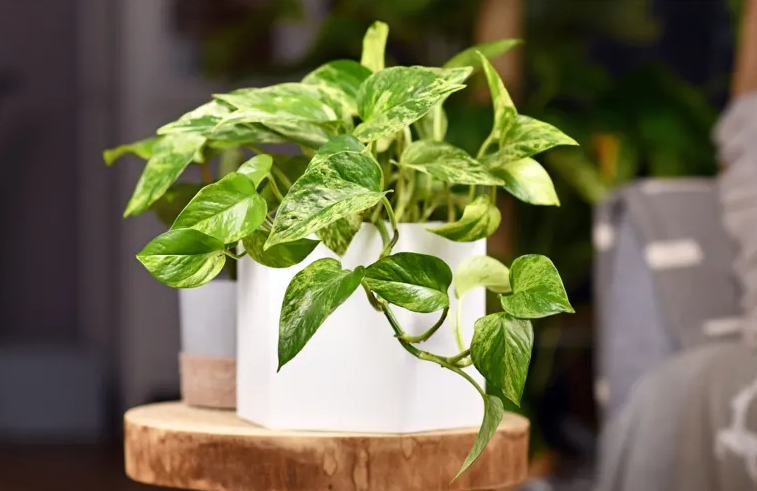
When talking about Pothos, Golden Pothos is no doubt one of the absolute best options. It is the most accessible and affordable variety you can pick up from a nursery around you.
If you are confused and trying to differentiate from the remaining options, we’d recommend looking at the shape of the leaf. It features the staple heart-shaped leaf with a bright green hue on each leaf. However, what give it the “Golden” title is the splashes of white and gold stripes on the leaf.
They are alternatively known as Devil’s Ivy since they are creepers. If you mount them with a stick or rod, they will climb up and create diverse foliage. The leaves and the plant, in general, are quite resilient. They can grow without much deliberation. So, once you have potted the plant, leave it to grow on its own.
You need to water it occasionally and that’s about it. Avoid over-watering the plant since that causes maximum complications. It can also damage the roots, leading to root rot and damage to the plants.
The only recommendation we’d suggest is to make the most use of the trailing feature. They are creepers and need the support to grow in the upward direction, so plan things accordingly. The Golden Pothos makes an amazing addition to your outdoor balcony décor.
2. Marble Queen Pothos
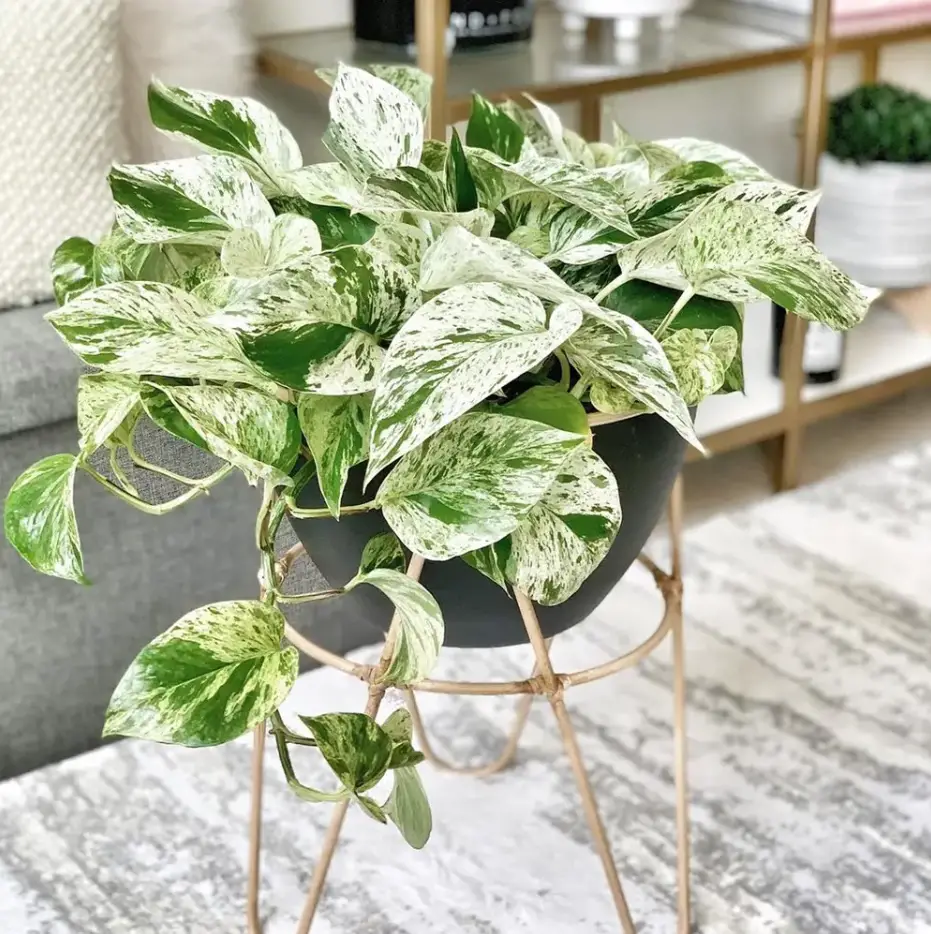
Next up is the Marble Queen Pothos, which is a type of tropical vine. Unlike Golden Pothos, the appearance of this one is quite different, as well as the care guide. You get a balanced combination of green and white on the heart-shaped leaves.
Some of the marble queen pothos has more white spots than green, giving them a very unique appearance. This is perfect for homes that have limited space. If you want to add a live plant but don’t want it to grow at an exponentially fast rate, this is your best bet.
The reason why the Marble Queen Pothos grows at such a slow rate is due to the lack of chlorophyll in it. It makes a good addition as a centerpiece to your living room. Also, since it doesn’t require a lot of water, you won’t have to worry about dirtying the area you keep it in.
Besides these, the only instruction we’d recommend following is the light requirements. The leaves are very sensitive to light. If the light parameters are very low and subtle, it will affect the leaves and turn them green from white.
Keeping them close to a natural light source also contributes to the steady growth and ensures the leaves look fresh and lively.
3. Neon Pothos
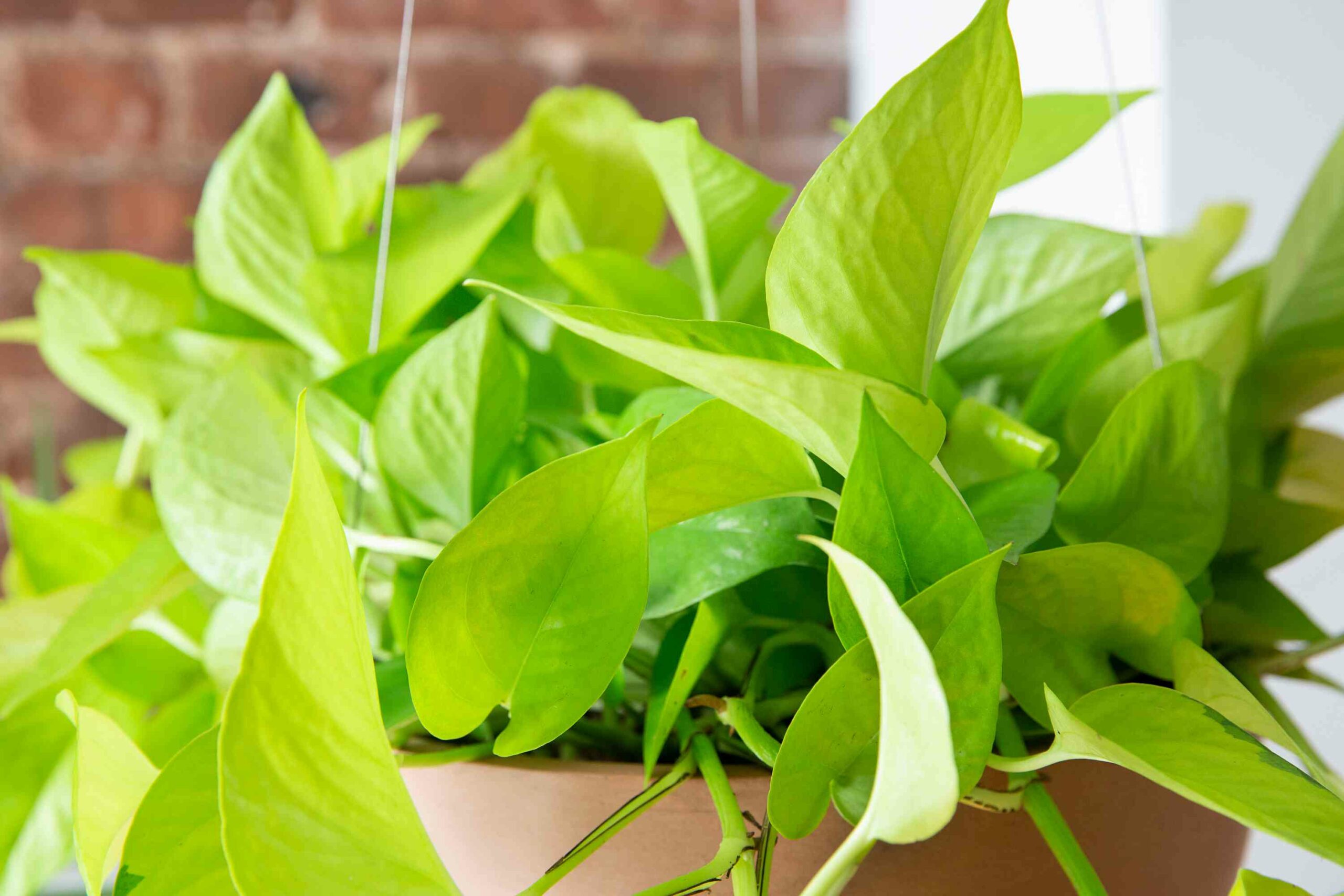
If there’s one variant of Pothos that takes the crown, it is the Neon Pothos. The all-green, heart-shaped leaves with the stunning appearance make it stand out from all the other options that you can think of.
Unlike most of the other types of pothos that feature a dark green color, Neon Pothos has a very light yet vibrant color to them, something that you won’t regret adding to your home. The shiny green makes a great addition to the center of your home. They also make good additions to the balcony décor.
The Neon Pothos is one of the few types that features a monochromatic appearance and has a uniform shape and color. Looking at these leaves makes you feel like they don’t have any kinds of imperfection, which is exactly true.
When it comes to care and growing tips, Neon Pothos needs bright but indirect light. Since they are all green in color, we’d highly recommend that you keep them close to a source of natural light. Lack of light will make the colors of the leaves fade away eventually.
4. Jessenia Pothos
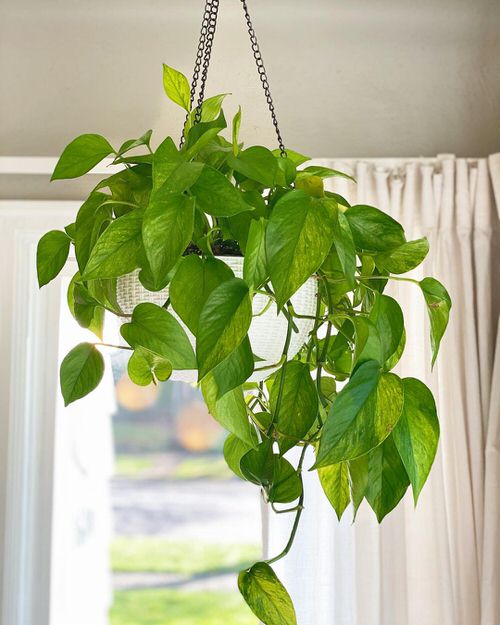
A lot similar to Golden Pothos, Jessenia Pothos features bright-green colored leaves but with bright yellow spotting and splotches all over. The marbling effect on the leaf stands out from the rest of the options that you’d come across.
Also, like Marble Queen, which features a uniform marble appearance all over, Jessenia Pothos is not that uniform. You do get a mix of green and yellow but every foliage is unique. Since the majority of the leaves are yellow, it is due to the lack of chlorophyll.
Because of that, you need to be mindful of the growth pattern. They grow at a very slow rate, compared to the other types of Pothos. The limey-green appearance of this Pothos is what sets it apart from the others. Just ensure that you keep it outdoors for sustained growth.
Besides the outdoor balcony setting, they can be kept indoors to spruce up the appearance of the bookcase or on the shelves in your home. Just ensure that you have a direct light source for steady growth.
5. Manjula Pothos
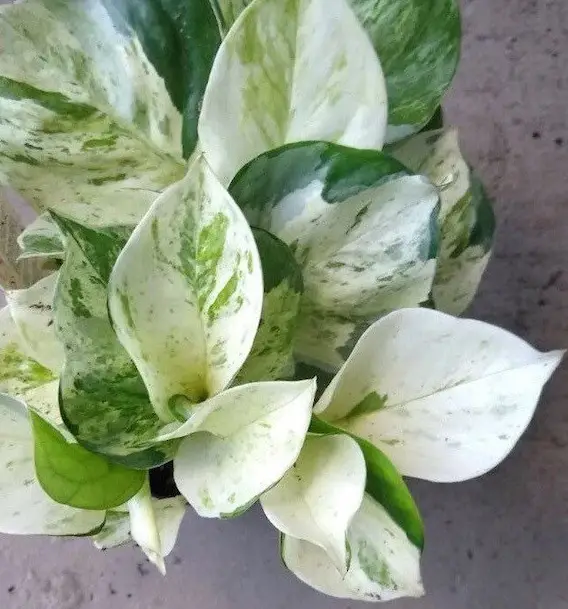
Although quite a mainstream type of Pothos, Manjula Pothos is a popular and patented type of Pothos that was first produced by the University of Florida. A first look at the Manjula Pothos will make you confuse it with Marble Queen Pothos since they have a very similar appearance.
Coming to the appearance of the Pothos, the Manjula Pothos features the staple heart-shaped appearance of the leaves but they have a curvy edge to them. So, when you try to lay the plant flat on a surface, it won’t lie flat.
As for the appearance, the leaves feature a mix of green, white, cream, and specks of silver on them. The uniqueness of this type of Pothos lies in its appearance. Each plant and each leaf have a different appearance to it, especially with the freckled patches on them.
When it comes to the light parameters, be assured that they need a balanced light setting. You can’t trust it in areas with extremely bright light or you can’t leave it in the shadows as well.
6. Pearls and Jade Pothos
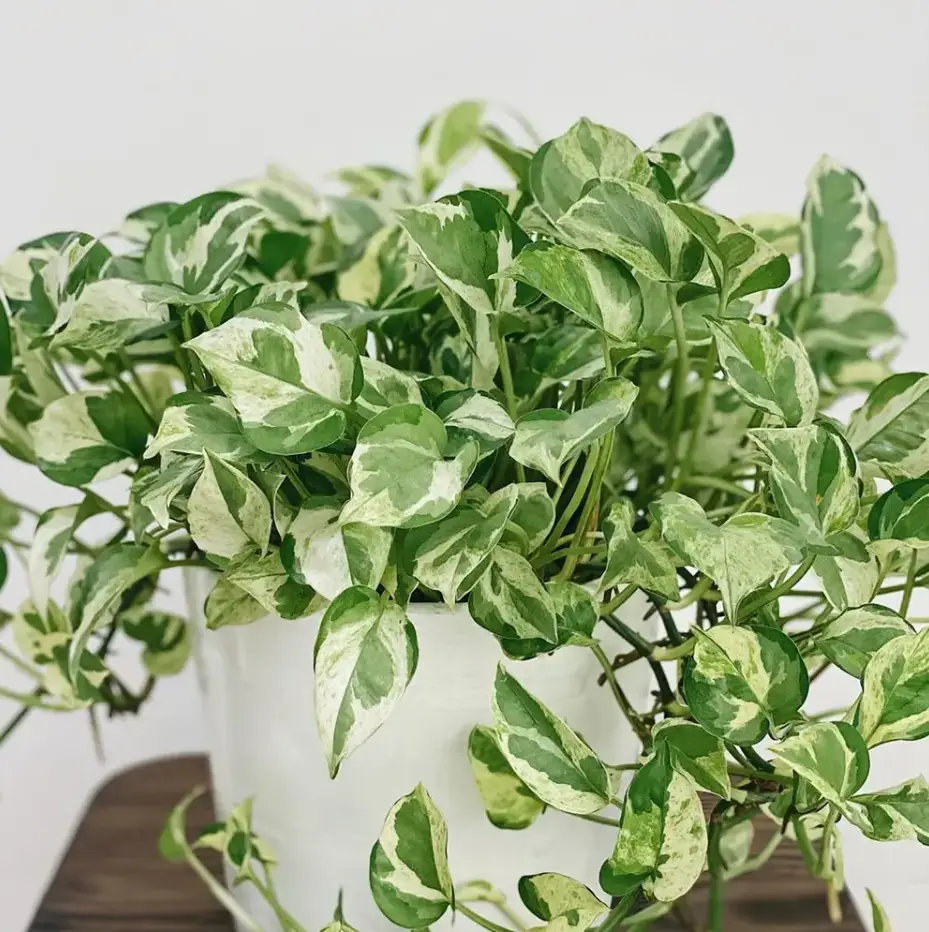
Looks like the University of Florida has a lot of different types of Pothos growing on their campus. Besides the Manjula Pothos, Pearls and Jade Pothos is also grown by the University of Florida. They do have the staple heart-shaped appearance of the leaves but with slightly elongated foliage.
Besides the dark green of the leaves, there are spots and specks of silver-gray and white all over the leaves that make it a stunning addition to your balcony or your indoor rooms. Since they are creepers, you can make use of that trait and propagate it throughout the perimeter of your home.
There is a certain level of uniformity with the variegation on the leaves. Instead of being spotted unevenly, the foliage has its variegation around the edge of the leaves. The silver shades on the leaf give it a unique and one-of-a-kind appearance.
Compared to the majority of the Pothos plants available in the market, the Pearls and Jade Pothos have smaller leaves than most of the other variants. This makes it easier for you to keep it and enhance the beauty of the room.
7. Silven or Satin Pothos
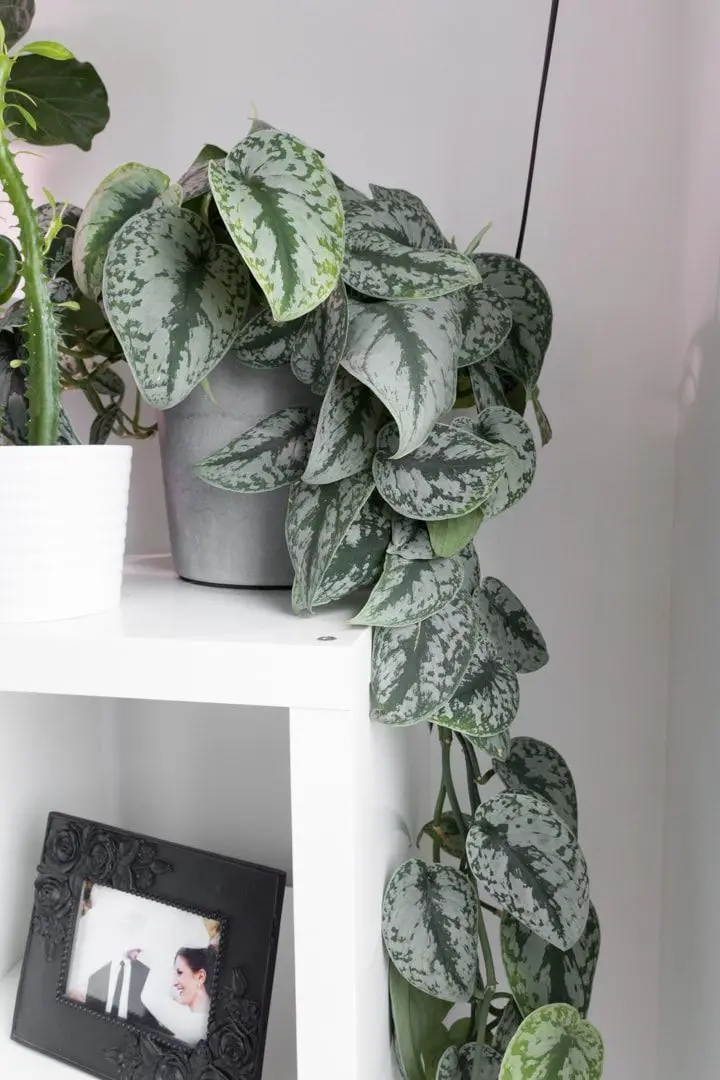
The Silver or Satin Pothos is unlike anything else in the variety of options. It has a striking appearance in many ways. The factor that makes it stand out from the rest of the Pothos is the fact that it’s a flowering plant. So, not just the foliage, it also supports optimal blooming.
The flowers are quite exotic as well, further adding to the credibility of the plant. When you first look at the bloom, you’d have a hard to distinguish it from a pine cone. The flower mimics the appearance of a pine cone but is white.
Like most Pothos, these are creepers too. When it comes to the appearance of the color of the leaves, the foliage features a deep but matt green color. It is more or less a monochromatic plant but has light green dots and specks all over the leaf.
They are known for their sculptural qualities and are popular decorative plants. Since they grow quite quickly and have dense foliage, we’d recommend keeping them separately so they don’t take up a lot of space on the shelves. They aren’t very easily accessible, so try and snag them from the local nurseries or online plant stores.
8. N-Joy Pothos
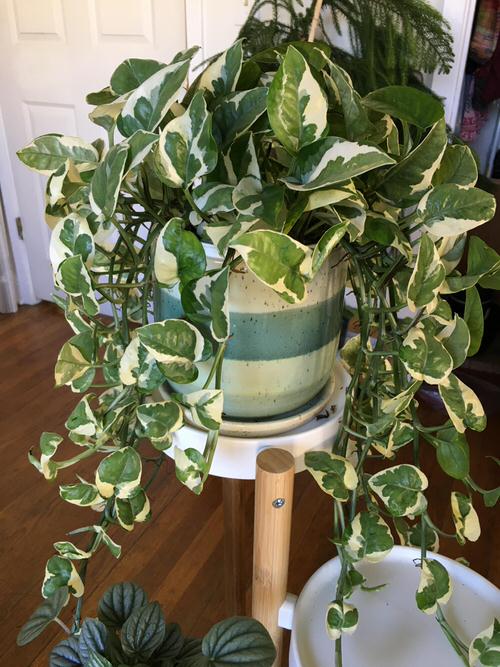
Scientifically termed as Epipremnum Aureum, N-Joy Pothos is quite a new variety of Pothos that is available in the market. It hasn’t been in the market for long and is a fairly newly bred variety of Pothos that is available in the market.
Its appearance isn’t very different from most of the other types of Pothos in the market and features a combination of green and white all over. The variegation is generally on the exterior of the leaves, with a special focus on the whites.
The unique trait of this type of Pothos is the interchanging colors. Since the white takes up the majority of the leaves, don’t be surprised when you see the green part changing colors. It is mainly due to the light intensity that falls on the individual foliage.
It is a decorative type of Pothos, so you need to purchase it before it becomes more and more mainstream in the market. Each leaf in the plant has a different appearance, which adds to the uniqueness of the plant.
Also, since the plant grows at a very quicker rate, you need to keep it separate or close to the ground level. This enables the plant to grow at a uniform rate without hindering or blocking the other items on the shelves.
9. Cebu Blue Pothos
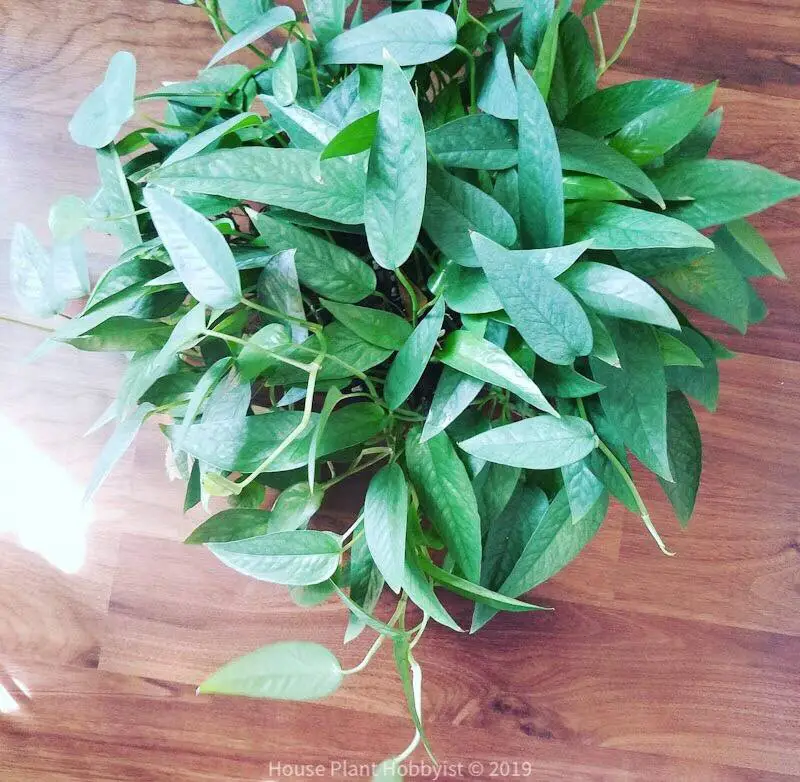
If the name wasn’t a giveaway, Cebu Blue Pothos is the only one on the list with a stunning deep-blue appearance. Besides the uniqueness of the color of the leaves, Blue Pothos also has a unique shape to the leaves.
The foliage is arrow-shaped instead of the standard heart shape. When you witness the leaves under sunlight, they have a slight silver sheen to them, which makes them stand out from the rest.
They don’t grow at a very fast rate but with constant natural light sources, they will grow at an exponentially faster rate. Due to their unique characteristics, they aren’t the easiest to the source. They do have an exotic and tropical vibe to them, which adds to the credibility.
Given their uniqueness, the plant isn’t very easily found in the market, so you need to make a conscious purchase decision. Besides the light setting, be careful of the temperature parameters with this one.
Conclusion
Pothos are easy to find, especially when it comes to common variants. They are decorative, exotic, and easy to care for. Which ones from the list are you considering adding to your list of houseplants in the future?
FAQs
1. Which is the rarest pothos?
Harlequin Pothos is the rarest form of pothos that is available in the market.
2. Can you put different types of pothos together?
Most varieties of Pothos require similar types of care, so you can plant a few different types of them together.
3. Is Snow Queen Pothos rare?
No, Snow queen is a very readily available form of pothos in the market.

